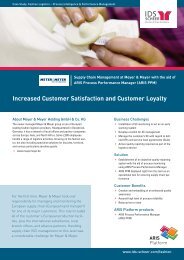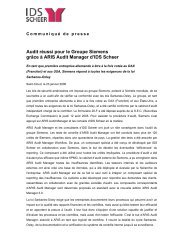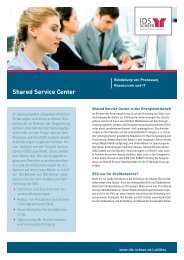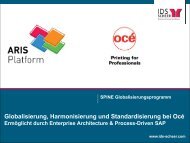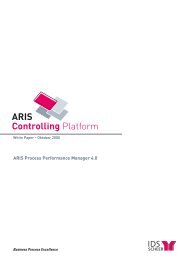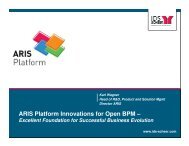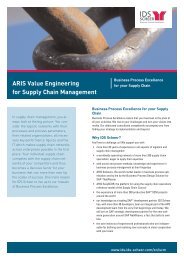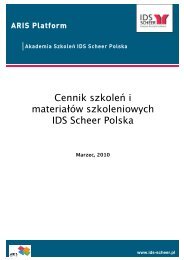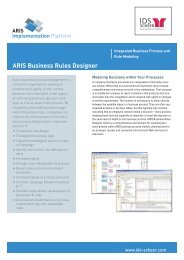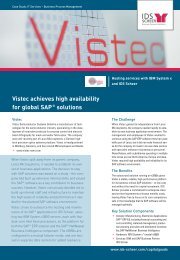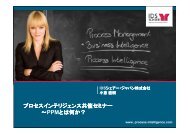ARIS Expert Paper - SAP Upgrade - IDS Scheer AG
ARIS Expert Paper - SAP Upgrade - IDS Scheer AG
ARIS Expert Paper - SAP Upgrade - IDS Scheer AG
Create successful ePaper yourself
Turn your PDF publications into a flip-book with our unique Google optimized e-Paper software.
<strong>ARIS</strong> <strong>Expert</strong> <strong>Paper</strong><br />
<strong>ARIS</strong><br />
Platform<br />
<strong>Expert</strong><br />
<strong>Paper</strong><br />
Aligning Business with IT<br />
Simplifying <strong>SAP</strong> <strong>Upgrade</strong>s Through<br />
Business Process Management (BPM)<br />
www.ids-scheer.com
<strong>ARIS</strong> <strong>Expert</strong> <strong>Paper</strong><br />
Simplifying <strong>SAP</strong> <strong>Upgrade</strong>s Through Business Process Management (BPM)<br />
Aligning Business with IT<br />
Many companies who are at mature stages of their <strong>SAP</strong> investments are<br />
struggling with the decision to upgrade.<br />
Is it necessary? Can’t the current system just be optimized? What are the<br />
business reasons for upgrading and what kind of an upgrade would be most<br />
beneficial for the company?<br />
How do companies get the most benefit out of a <strong>SAP</strong> upgrade project through<br />
business process management (BPM). How do they define their <strong>SAP</strong><br />
upgrade requirements in the areas of a technical, functional or strategic<br />
upgrade? How do they cut project times and costs for <strong>SAP</strong> upgrade projects<br />
using standardized methodologies? And most importantly, how do companies<br />
truly align business with your IT?<br />
Find out how companies can:<br />
� Get the most benefit out of a <strong>SAP</strong> upgrade project through<br />
business process management<br />
� Cut project times for upgrade projects using standardized<br />
methodologies<br />
� Align business with IT<br />
The Business Drivers for Upgrading <strong>SAP</strong> with <strong>IDS</strong> <strong>Scheer</strong><br />
The <strong>SAP</strong> <strong>Upgrade</strong>s Scenario by <strong>IDS</strong> <strong>Scheer</strong> combines the market-leading <strong>ARIS</strong><br />
Business Architect for <strong>SAP</strong> software with a technical diagnostic service for your<br />
as-is <strong>SAP</strong> landscape, bundled in a business process offering that helps to effectively<br />
run an <strong>SAP</strong> upgrade project based on the business processes actually<br />
used.<br />
The offering enables companies to:<br />
� Perform a fully comprehensive as-is analysis of the current <strong>SAP</strong> (4.x)<br />
processes and configuration with RBE (Reverse Business Engineering);<br />
� Identify sub-optimal business processes, out-of-date functions, and thirdparty<br />
application consolidation opportunities;<br />
� Design an agile to-be <strong>SAP</strong> business process strategy that leverages ERP<br />
6.0, <strong>SAP</strong> Business Suite, and SOA;<br />
� Accelerate the upgrade blueprint phase via collaborative business / IT<br />
process design based on standard, proven <strong>SAP</strong> reference processes.<br />
Some of the key benefits include:<br />
� Alignment and improved communication between IT and businesses;<br />
� 20 - 40% reduction in blueprinting costs;<br />
� Ability to go live faster and better;<br />
� Savings through the reduction of custom features and unused transactions.<br />
2<br />
About the Authors<br />
Eric Brabänder<br />
is Head of global <strong>ARIS</strong> Product<br />
Marketing at <strong>IDS</strong> <strong>Scheer</strong> <strong>AG</strong>. He<br />
supported the strategic development<br />
cooperation with <strong>SAP</strong> <strong>AG</strong> as<br />
responsible product manager for<br />
<strong>ARIS</strong> for <strong>SAP</strong>.<br />
Fabian Erbach<br />
is the Head of the Center of<br />
Excellence at <strong>IDS</strong> <strong>Scheer</strong> <strong>AG</strong>,<br />
responsible for the <strong>ARIS</strong> Solution<br />
for Process-Driven <strong>SAP</strong><br />
Management. He manages the<br />
development of <strong>IDS</strong> <strong>Scheer</strong>‘s standard<br />
approach, <strong>ARIS</strong> Value<br />
Engineering (AVE) for <strong>SAP</strong> and<br />
oversees its global roll-out and<br />
implementation in the field.<br />
Contact:<br />
arisproductmarketing@ids-scheer.com
In addition to reducing the cost of the <strong>SAP</strong> system environment, the <strong>SAP</strong> <strong>Upgrade</strong> Scenario harmonizes and standardizes<br />
business processes, providing a solid foundation for future <strong>SAP</strong> ERP upgrades and <strong>SAP</strong> NetWeaver deployments.<br />
This <strong>Expert</strong> <strong>Paper</strong> provides the answers to the most critical questions on upgrading <strong>SAP</strong> and how the Process-Driven <strong>SAP</strong><br />
<strong>Upgrade</strong> Scenario from <strong>IDS</strong> <strong>Scheer</strong> will simplify it through effective Business Process Management (BPM).<br />
� Which potential process improvements can we achieve by upgrading?<br />
� How can I close the gap between business requirements, business process design, and <strong>SAP</strong> implementation?<br />
� How can I make sure my blueprint documentation matches the actual implementation?<br />
� Which parts of my business can be mapped using <strong>SAP</strong> standard functionalities and where do I need to change <strong>SAP</strong>?<br />
� How can I standardize and consolidate different business processes and applications?<br />
� How can I ensure that my end-to-end business processes are implemented in <strong>SAP</strong>?<br />
� How can I better communicate with and train <strong>SAP</strong> end users during and after the upgrade?<br />
� How can I cut the project time for <strong>SAP</strong> upgrades?<br />
<strong>SAP</strong> <strong>Upgrade</strong>s Offer Strategic Opportunities<br />
The decision driver for upgrading <strong>SAP</strong> has often been to ensure fast availability of executable solutions. Unfortunately,<br />
acting on this driver alone means that the system’s enormous capabilities and benefits cannot be realized. Best practices<br />
for upgrades require comprehensive analysis and process-oriented documentation of existing systems.<br />
<strong>SAP</strong> ® User Group Group delegates at recent upgrade symposiums agreed that building the business case and planning<br />
the upgrade project were the two most critical issues. All too often, many aspects of the environment are simply<br />
unknown, making it impossible to compile this information. The business case needs a solid foundation that includes both<br />
business and IT drivers. With the help of <strong>IDS</strong> <strong>Scheer</strong>’s offerings, organizations can now link their <strong>SAP</strong> upgrade program<br />
to business strategy, operational excellence, sustainability, and TCO reduction. At the same time, next-generation <strong>SAP</strong><br />
solutions need to be business process-driven and focused on innovation and growth.<br />
There have been significant innovations to <strong>SAP</strong> ® R/3 ® 4.6. Today, CIOs want to transform their organizations into agile,<br />
SOA-ready enterprises. IT leadership now needs to map the path from technical upgrade through functional upgrade to<br />
strategic upgrade in order to leverage strategic opportunities:<br />
� Technical upgrade – Retain existing functionality, migrate database to Unicode, if required.<br />
� Functional upgrade – Enable new and optimized business processes based on new ERP & industry-solution functionality.<br />
� Strategic upgrade – First step to Enterprise SOA; enrich new business processes with enterprise services.<br />
This path from technical to functional and strategic upgrade is supported by <strong>IDS</strong> <strong>Scheer</strong>’s <strong>SAP</strong> <strong>Upgrade</strong> Scenario in the<br />
<strong>ARIS</strong> Solution for Process-Driven <strong>SAP</strong> Management.<br />
Using <strong>ARIS</strong> Solutions as a Basis for <strong>SAP</strong> <strong>Upgrade</strong>s<br />
<strong>ARIS</strong> <strong>Expert</strong> <strong>Paper</strong><br />
<strong>ARIS</strong> Solutions combine selected <strong>ARIS</strong> products with the <strong>ARIS</strong> Value Engineering procedural models designed to meet<br />
specific needs. These specialist solution portfolios have proven successful in numerous customer projects. Leveraging<br />
this experience enables fast, cost-effective creation of customized solutions.<br />
All solutions are based on the central, integrated <strong>ARIS</strong> repository, so data can be exchanged and processed across multiple<br />
solutions. All the targeted user groups – the organizational department and management, operational and IT departments,<br />
and financial controllers – work in an integrated environment. Integrated process management is therefore possible<br />
throughout the enterprise.<br />
<strong>SAP</strong> ® software helps enterprises to implement business processes. But how can companies ensure that the processes<br />
incorporated in the standard software properly reflect their corporate strategy? What is the best way to meet the requirements<br />
of the sales, marketing, procurement, and production departments in your <strong>SAP</strong> ® system?<br />
3
<strong>ARIS</strong> <strong>Expert</strong> <strong>Paper</strong><br />
The <strong>ARIS</strong> Solution for Process-<br />
Driven <strong>SAP</strong> Management supports<br />
companies throughout the<br />
entire <strong>SAP</strong> ® lifecycle, from strategy<br />
and requirements analysis<br />
through blueprinting to configuration,<br />
testing, training, and rollout.<br />
Business processes are documented<br />
using <strong>ARIS</strong> Business<br />
Architect for <strong>SAP</strong> and analyzed<br />
within the context of the <strong>SAP</strong> system<br />
environment.<br />
Taking a comprehensive, pro -<br />
cess-centric approach to <strong>SAP</strong> ®<br />
initiatives by using the <strong>ARIS</strong> Value<br />
Engineering (AVE) approach and<br />
procedural model, this solution<br />
helps users to analyze, define,<br />
validate, and manage the business<br />
value of enterprise SOA<br />
technologies from <strong>SAP</strong>.<br />
<strong>ARIS</strong> Solution for Process-Driven <strong>SAP</strong> Management currently supports application scenarios for <strong>SAP</strong> ® implementation,<br />
<strong>SAP</strong> upgrade, and enabling enterprise SOA.<br />
<strong>ARIS</strong> Value Engineering<br />
Content is king! Knowing how best to deploy processes and products is becoming crucial to success and key to increasing<br />
speed. <strong>IDS</strong> <strong>Scheer</strong>’s BPM experts have responded to this need by developing the <strong>ARIS</strong> Value Engineering Framework,<br />
which bundles tried-and-tested procedural models, best practices, and application methods with <strong>ARIS</strong> Platform tools.<br />
The <strong>ARIS</strong> Value Engineering (AVE) procedural models are designed to support the complete business process lifecycle –<br />
from strategy, design, and implementation to controlling. Each phase contains tool-supported AVE work packages that<br />
describe how to achieve a specific result (the AVE work product) via recommended AVE work steps. Pre-configured<br />
questionnaires, reference processes, and templates accelerate creation and implementation of the work products.<br />
The sequential work packages in the procedural models guide users through a project. Customers benefit in two ways:<br />
First, projects can be launched faster; and second, this equips customers for future upgrades because all tools and solutions<br />
are based on a common architecture. Customization to meet the specific needs of individual organizations is another<br />
valuable feature.<br />
The modular design concept means that project results can be reused in other scenarios. For example, processed packages<br />
from the AVE for <strong>SAP</strong> procedural model can be reused in an SOA project, allowing enterprises to leverage their initial<br />
investment many times over. The <strong>ARIS</strong> Value Engineering Framework is being continually upgraded to meet new challenges.<br />
All procedural models share a process management-oriented approach (i. e., describing processes, implementing<br />
processes, and monitoring processes). The <strong>ARIS</strong> Platform repository guarantees that processes are homogeneous and<br />
transparent. Rather than being empty shells, the tools incorporated into the AVE procedural models already include the<br />
required standards, guidelines, support (AVE accelerators), and sample solutions (best practices) to prevent enterprises<br />
from having to reinvent the wheel over and over. This creates ideal conditions for significantly accelerating project implementation<br />
and boosting quality.<br />
4
The <strong>ARIS</strong> Platform as a Foundation<br />
<strong>IDS</strong> <strong>Scheer</strong> has been optimizing business processes for over 20 years, gaining a wealth of business process management<br />
(BPM) experience that has driven the development of <strong>ARIS</strong> Platform products. Research by leading technology analysts<br />
highlights the market-leading position enjoyed by <strong>ARIS</strong> Platform due to this combination of extensive project experience<br />
and innovative software development.<br />
With its intuitive user interface, smart Web technologies, and high level of scalability, <strong>ARIS</strong> is the benchmark for enterprise-wide<br />
BPM and other process-oriented solutions. Integration with various modeling methods and frameworks, such<br />
as, EPC, UML, BPEL, BPMN, ITIL, TOGAF, DoDAF, TEAF/FEAF, ArchiMate, and Zachman, supports the deployment of <strong>ARIS</strong><br />
in many different business areas. All these methods are combined in the central <strong>ARIS</strong> repository.<br />
The <strong>ARIS</strong> Platform and the optimized combination of the integrated components are the basis for every <strong>ARIS</strong> Solution.<br />
<strong>ARIS</strong> Products and Tools Used in the <strong>SAP</strong> <strong>Upgrade</strong> Scenario<br />
To upgrade <strong>SAP</strong> systems, a number of different tools are used during the individual project phases:<br />
<strong>ARIS</strong> Business Architect<br />
<strong>ARIS</strong> Business Architect is Web-based and supports professional, enterprise-wide business<br />
process modeling. It offers maximum flexibility for modeling, analyzing, and optimizing business<br />
processes and benefits from an intuitive user interface.<br />
<strong>ARIS</strong> Business Architect contains extensive functionality for administering <strong>ARIS</strong> databases,<br />
users, scripts, etc. Alongside proven methods like Event-driven Process Chains (EPC), <strong>ARIS</strong> also supports BPMN, BPEL,<br />
UML, and other architecture concepts, such as, DoDAF, IT City Planning, and Zachman.<br />
<strong>ARIS</strong> Business Designer<br />
<strong>ARIS</strong> Business Designer is the Web-based tool for getting started with end-to-end business<br />
process modeling. With its client-server architecture and enhanced user interface, <strong>ARIS</strong><br />
Business Designer allows even non-technical users to design professional business processes.<br />
All <strong>ARIS</strong> tools are based on a central repository, ensuring that process models are consistent<br />
and can be recycled. This means that business process design is possible on a global<br />
scale via access to this central resource.<br />
<strong>ARIS</strong> Business Architect for <strong>SAP</strong><br />
<strong>ARIS</strong><br />
Business Architect for <strong>SAP</strong><br />
<strong>ARIS</strong> Business Architect for <strong>SAP</strong> enables enterprises to define business management<br />
re quirements from a process perspective. Requirements are mapped using<br />
business process models and can be enriched with all the necessary additional<br />
information and subjected to analysis. Bidirectional integration with <strong>SAP</strong> ® Solution<br />
Manager enables the models to be constructed on the basis of <strong>SAP</strong> ® reference con-<br />
tent for a process-based <strong>SAP</strong> ® solution. They can then be seamlessly implemented in <strong>SAP</strong> Solution Manager.<br />
<strong>ARIS</strong> Business Publisher<br />
<strong>ARIS</strong> Business Publisher guarantees permanent, low-cost availability of process information<br />
via Web-based portals, plus publishing of business processes and related <strong>SAP</strong> upgrade information.<br />
Due to rights-based and role-based access to process models, content is only displayed<br />
to the relevant target group. This prevents users from being overwhelmed and protects<br />
critical process knowledge. All portal content is dynamically generated when the user signs in, thus minimizing export<br />
times and guaranteeing up-to-the-minute information for decision-making. All <strong>SAP</strong>-supported business processes and<br />
end-to-end process models can be published using <strong>ARIS</strong> Business Publisher. This published information enables greater<br />
process transparency, while also supporting test descriptions and end-user training. <strong>SAP</strong> ® transactions can be directly<br />
accessed via the published business process model.<br />
<strong>ARIS</strong> Business Server<br />
<strong>ARIS</strong> <strong>Expert</strong> <strong>Paper</strong><br />
<strong>ARIS</strong> Business Server facilitates <strong>ARIS</strong> multi-user capabilities, user management, access rights<br />
management, and worldwide access by different <strong>ARIS</strong> Platform products to a central database.<br />
<strong>ARIS</strong> Business Server also enables optimal resource management and load balancing in multiuser<br />
environments.<br />
5
<strong>ARIS</strong> <strong>Expert</strong> <strong>Paper</strong><br />
<strong>SAP</strong> Solution Manager<br />
<strong>SAP</strong> Solution Manager is a centralized, robust solution management toolset that facilitates implementation<br />
and operations support for distributed systems – with functionality that covers all key<br />
aspects of solution deployment, operation, and continuous improvement. It combines tools, content,<br />
and direct access to <strong>SAP</strong> to increase the reliability of solutions and reduce total cost of ownership.<br />
<strong>SAP</strong> Solution Manager addresses the entire IT environment, supporting both <strong>SAP</strong> and non-<strong>SAP</strong> software and covering<br />
current and forthcoming <strong>SAP</strong> solutions. As part of <strong>SAP</strong> NetWeaver, <strong>SAP</strong> Solution Manager is included in the annual maintenance<br />
fee for <strong>SAP</strong> solutions. <strong>SAP</strong> Solution Manager targets both technical and business aspects of <strong>SAP</strong> solutions,<br />
focusing strongly on core business processes. It supports the connection between business processes and the underlying<br />
IT infrastructure by offering <strong>SAP</strong> process and implementation reference content. As a result, together with <strong>ARIS</strong><br />
Platform products it facilitates communication between the IT department and users. In short, <strong>SAP</strong> Solution Manager<br />
ensures that an organization’s IT investments are leveraged to maximum effect.<br />
<strong>ARIS</strong> Process Performance Manager<br />
<strong>ARIS</strong> Process Performance Manager (<strong>ARIS</strong> PPM) helps enterprises to analyze<br />
IT-based business processes, agreements, and workflows. Its comprehensive<br />
analysis functions reveal the best-practice processes that can be reused with -<br />
in the organization.<br />
<strong>ARIS</strong> PPM is a patented software product that leverages key performance indicators to visualize, document, and assess<br />
“real-world” corporate processes in IT systems. Using actual processes, <strong>ARIS</strong> PPM generates intuitive management<br />
dashboards that display the current corporate objectives and communication relationships. An integrated early warning<br />
system (Early Alert) automatically monitors each step and issues an alarm in the event of deviation from planned values.<br />
<strong>ARIS</strong> PPM thus makes a key contribution to achieving sustained improvement in business processes.<br />
<strong>ARIS</strong> Value Engineering for <strong>SAP</strong>: A Roadmap for <strong>Upgrade</strong>s<br />
The <strong>ARIS</strong> Value Engineering (AVE) approach developed by <strong>IDS</strong> <strong>Scheer</strong> <strong>AG</strong> for managing <strong>SAP</strong> systems (AVE for <strong>SAP</strong>) is a<br />
holistic, model-based framework that covers all key aspects of an ERP implementation (processes, systems, data, organization).<br />
It is aligned with <strong>SAP</strong>’s popular Accelerated<strong>SAP</strong> (A<strong>SAP</strong>) roadmap methodology and comprises three major<br />
Solution Scenarios:<br />
� <strong>SAP</strong> Implementation<br />
� Enabling Enterprise SOA<br />
� <strong>SAP</strong> <strong>Upgrade</strong><br />
All these approaches support working with and toward <strong>SAP</strong>, providing a sophisticated set of procedures and accelerators<br />
that optimize <strong>SAP</strong> implementation and upgrade projects.<br />
AVE for <strong>SAP</strong> is more than just a<br />
framework; rather, it is a complete<br />
cycle that includes every phase of<br />
business process management<br />
from strategy, design, and implementation<br />
to controlling.<br />
Standardized work packages and<br />
products are defined for each<br />
phase. These build on each other<br />
and are created in <strong>ARIS</strong> Business<br />
Architect for <strong>SAP</strong> and <strong>SAP</strong><br />
Solution Manager. The result is an<br />
exact definition of the content<br />
required in the individual phases<br />
of the project, the form in which it<br />
needs to be created, and information<br />
on which tools support each<br />
of the phases. This ensures a consistent<br />
approach and process-oriented<br />
view.<br />
6
<strong>ARIS</strong> <strong>Expert</strong> <strong>Paper</strong><br />
The work packages themselves are shared among other AVE Solution Scenarios and can be combined with other<br />
approaches, e.g., in order to add IT architecture information or specific compliance requirements to an <strong>SAP</strong> upgrade project.<br />
The standard procedure and work packages can also be adapted to suit individual customer situations and needs.<br />
Deployment of <strong>ARIS</strong> Business Architect for <strong>SAP</strong> and <strong>SAP</strong> Solution Manager ensures that the required information is centrally<br />
documented, re-used where possible, and properly structured. The documentation includes a description of how<br />
the company’s business process requirements are realized in terms of software.<br />
Effective analysis of the existing <strong>SAP</strong> system, both from a process and a technical point of view, is a key aspect of every<br />
upgrade project. Based on the defined migration scope, <strong>SAP</strong> systems are examined with regard to used or unused transactions,<br />
custom features, system<br />
settings, and user exits in order to<br />
get a clear picture of the <strong>SAP</strong> ®<br />
capabilities that are currently<br />
supporting the business processes.<br />
Business processes are then<br />
created and adapted to the customer’s<br />
needs to provide a basis<br />
for designing the (business)<br />
upgrade blue print. All these activities<br />
are described in the work<br />
packages that make up the <strong>SAP</strong><br />
<strong>Upgrade</strong> roadmap, helping to<br />
streamline and plan the project.<br />
In addition to the roadmap and its<br />
work packages, the AVE approach<br />
provides a defined set of work<br />
products that are the result of the<br />
work packages and deliver value<br />
to the customer. The range of<br />
work products covers everything from system transformation during the strategy phase, where the planned system<br />
changes are documented (e.g., migrating two <strong>SAP</strong> ® R/3 ® systems to one <strong>SAP</strong> ® ERP 6.0 system), to technical upgrading,<br />
where customizing settings are applied.<br />
Focusing on a process-oriented upgrade allows customers to establish which functionalities they really need and how<br />
these identified business capabilities can best be supported by the new system – and implemented efficiently. Generation<br />
of business processes is supported by a semi-automated approach called <strong>SAP</strong> Redocumentation. Based on <strong>SAP</strong> ®<br />
Reverse Business Engineer (RBE) and its siblings, it allows automatic gathering of technical data and process information,<br />
which is the basis for creating process models and a specific <strong>SAP</strong> upgrade recommendation.<br />
7
<strong>ARIS</strong> <strong>Expert</strong> <strong>Paper</strong><br />
How to Benefit from the Process-Driven <strong>SAP</strong> Solution<br />
Strategy Phase<br />
Before starting an <strong>SAP</strong> upgrade project, it is<br />
important to define the exact objectives,<br />
based on the organization’s business,<br />
process, and IT strategy. During the strategy<br />
phase, the company can then obtain information<br />
about the relevant solutions available<br />
from <strong>SAP</strong>. The ability to evaluate a desired<br />
business scenario without defining individual<br />
components, or to create custom scenarios,<br />
enables an early insight into the way <strong>SAP</strong><br />
sees the individual processes and which<br />
<strong>SAP</strong> ® products are needed in order to support<br />
the planned scenario.<br />
The typical starting point for a process-oriented<br />
<strong>SAP</strong> upgrade is defining the process<br />
architecture. A company’s process architecture<br />
describes its business processes consistently<br />
from a purely business management<br />
level, through a configuration-oriented view, down to an integrated description of executable processes. Work on the<br />
process architecture commences with an Enterprise Process Map. This describes the core, management, and support<br />
activities, helping to establish which process areas are directly impacted by the <strong>SAP</strong> upgrade and which process areas<br />
are only partly affected.<br />
A complete process architecture thus supports seamless integration of processes across all aspects of customer relationship<br />
management, e-commerce, supply chain management, and business intelligence. These processes connect the<br />
various multi-level systems used by purchasers and sales staff, as well as customers and suppliers (end-to-end).<br />
In addition to the process architecture and end-to-end scenario that describe the business variants of processes, the<br />
system landscape and its planned transformation play an important role during an <strong>SAP</strong> upgrade. In many cases, the technical<br />
upgrade is accompanied by<br />
a consolidation of systems and<br />
therefore also a harmonization of<br />
processes: many processes that<br />
were distributed over several<br />
systems will now run on a limited<br />
number of new systems.<br />
Strategic planning of the <strong>SAP</strong><br />
upgrade helps to determine the<br />
full scope of the project and the<br />
impacted company assets, such<br />
as, processes, departments, and<br />
systems. The output of the planning<br />
process can later be reused<br />
to manage the project and facilitate<br />
process-oriented upgrades<br />
in the future. Companies can also<br />
identify system- and processrelated<br />
KPIs for monitoring<br />
processes and IT performance while the process-oriented upgrade is being carried out.<br />
8
Design Phase<br />
With <strong>SAP</strong> <strong>Upgrade</strong> Scenario from <strong>IDS</strong> <strong>Scheer</strong>, companies can quickly determine which processes are actually running<br />
on their systems. The redocumentation approach to generating this information runs semi-automatically and does not<br />
involve experts devoting valuable<br />
time to protracted interviews. It<br />
also helps to establish the real asis<br />
usage situation, rather than<br />
relying on user perceptions. Only<br />
then can a company deploy a system<br />
to maximum advantage.<br />
During <strong>SAP</strong> redocumentation,<br />
process-related configuration<br />
information and adaptations or<br />
extensions to <strong>SAP</strong> systems are<br />
evaluated with reference to special<br />
<strong>SAP</strong> ® reports. This information<br />
is then automatically consolidated<br />
and linked to the <strong>SAP</strong> reference<br />
content in <strong>SAP</strong> Solution<br />
Manager. The reference content<br />
is synchronized with <strong>ARIS</strong> Business Architect for <strong>SAP</strong> and used as the starting point for more in-depth analysis, optimization<br />
recommendations, and the requirements description for future processes in the <strong>SAP</strong> ® landscape. This procedure<br />
delivers both technical and process-oriented results.<br />
Although <strong>SAP</strong> Solution Mana ger<br />
plays an important role during the<br />
<strong>SAP</strong> upgrade, it is not a requirement<br />
in the design phase. It is<br />
therefore possible to create<br />
design deliverables, such as, the<br />
<strong>SAP</strong> upgrade recommendation<br />
report or to-be processes, which<br />
are synchable with <strong>SAP</strong> Solution<br />
Manager, before <strong>SAP</strong> Solution<br />
Mana ger has actually been<br />
installed.<br />
During the project, customers can<br />
discover the answers to the following<br />
questions:<br />
� Who uses which functionalities<br />
and how often?<br />
� Which business processes<br />
have been implemented, but<br />
are never used?<br />
� Which customer-specific transactions and reports do we have, how frequently are they used, and who created<br />
them?<br />
� Which functions should be prioritized during an upgrade?<br />
� What are the usage differences between the various <strong>SAP</strong> ® R/3 ® systems?<br />
<strong>ARIS</strong> <strong>Expert</strong> <strong>Paper</strong><br />
� What is the best way to relate system-supported processes back to the standard process in the event of an<br />
upgrade?<br />
9
<strong>ARIS</strong> <strong>Expert</strong> <strong>Paper</strong><br />
Implementation Phase<br />
All these questions are answered<br />
through the aid of <strong>ARIS</strong> Platform<br />
products. Technical indicators<br />
can be assigned to modeled business<br />
processes. Planned<br />
processes transformations from<br />
as-is to to-be can be both visually<br />
presented to management and<br />
analyzed with regard to impacted<br />
processes and the possible need<br />
for organizational changes.<br />
<strong>SAP</strong> Solution Manager plays the leading role during the deployment phase. To enable configuration of the individual<br />
processes, the user can go straight from a structure element in <strong>ARIS</strong> to the <strong>SAP</strong> Solution Manager configuration view.<br />
Test scenarios can then be created in Solution Manager based on the end-to-end scenarios defined in <strong>ARIS</strong>. In a later<br />
phase of the project, the intended users of the <strong>SAP</strong> system will be trained on how to handle transactions in the context<br />
of business processes.<br />
All these activities are based on the business processes that are generated during redocumentation and synchronized<br />
between the <strong>ARIS</strong> Platform and <strong>SAP</strong> Solution Manager.<br />
Inside <strong>SAP</strong> Solution Manager,<br />
accelerators, such as, upgrade<br />
roadmaps and upgrade content,<br />
support the steps needed to perform<br />
the technical upgrade.<br />
Another advantage of using the<br />
<strong>ARIS</strong> Platform to document <strong>SAP</strong> ®<br />
blueprints is the standardization<br />
of <strong>SAP</strong> blueprints across decentralized<br />
locations. In many global<br />
businesses, <strong>SAP</strong> systems are initially<br />
implemented at one location,<br />
and these defined systems<br />
are subsequently rolled out to<br />
other sites. However, the systems<br />
are usually inadequately documented,<br />
which can lead to costly<br />
delays or inconsistent system settings.<br />
The ability to link process models<br />
with <strong>SAP</strong> ® transactions via <strong>ARIS</strong><br />
Business Architect for <strong>SAP</strong> and to connect <strong>SAP</strong> transactions to process models (<strong>ARIS</strong> Online Guide), combined with the<br />
multilingual capability of <strong>ARIS</strong>, enables optimum implementation of the defined system in near-real time at all locations.<br />
Docu mentation can be maintained centrally and exchanged worldwide via an intranet or the Internet. Adaptations to the<br />
basic system which are necessary to meet country- and company-specific requirements are then planned and documented<br />
at the individual sites.<br />
10
Controlling Phase<br />
Deploying <strong>ARIS</strong> PPM offers the following benefits:<br />
� Extraction of process data from IT systems<br />
� Auto-visualization of real-world processes using reverse modeling technology<br />
� Communication and organizational analysis<br />
� Management dashboards for top-level overviews, plus a powerful reporting engine<br />
<strong>ARIS</strong> <strong>Expert</strong> <strong>Paper</strong><br />
Implementation is followed by the controlling phase,<br />
in which business, system, and organizational performance<br />
can be monitored. A cost/benefit calculation<br />
is conducted at the same time to allow any necessary<br />
corrective action to be taken.<br />
Using actual processes, <strong>ARIS</strong> Process Performance<br />
Manager (PPM) generates intuitive management<br />
dashboards that display the current corporate objectives<br />
and communication relationships. An integrated<br />
early warning system (EarlyAlert) automatically monitors<br />
each step and issues an alarm in the event of<br />
deviation from planned values. <strong>ARIS</strong> PPM thus makes<br />
a key contribution to achieving sustained improvement<br />
in business processes. The measurement is<br />
based on the key performance indicators defined during<br />
the strategy phase of the <strong>SAP</strong> <strong>Upgrade</strong> project.<br />
11
<strong>ARIS</strong> <strong>Expert</strong> <strong>Paper</strong><br />
© Copyright <strong>IDS</strong> <strong>Scheer</strong> <strong>AG</strong>, Saarbruecken, 2007. All rights reserved. The contents of this document are subject to copyright. Any changes, modifications, additions<br />
or amendments require prior written consent from <strong>IDS</strong> <strong>Scheer</strong> <strong>AG</strong>, Saarbruecken. Reproduction in any form is only permitted on the condition that the copyright<br />
notice remains on the actual document. Publication or translation in any form requires prior written consent from <strong>IDS</strong> <strong>Scheer</strong> <strong>AG</strong>, Saarbruecken. “<strong>ARIS</strong>”, “<strong>IDS</strong>” ,<br />
“ProcessWorld”, “PPM”, <strong>ARIS</strong> with Platform symbol and Y symbol are trademarks or registered trademarks of <strong>IDS</strong> <strong>Scheer</strong> <strong>AG</strong> in Germany and in many other<br />
countries worldwide. “<strong>SAP</strong> NetWeaver” is a trademark of <strong>SAP</strong> <strong>AG</strong>, Walldorf. All other trademarks are the property of their respective owners.<br />
ID-Number: EP-<strong>SAP</strong>-1208-E<br />
<strong>ARIS</strong><br />
Platform<br />
<strong>Expert</strong><br />
<strong>Paper</strong><br />
<strong>IDS</strong> <strong>Scheer</strong> <strong>AG</strong><br />
Headquarters<br />
Altenkesseler Str. 17<br />
66115 Saarbruecken<br />
Phone: +49 681 210-0<br />
Fax: +49 681 210-1000<br />
E-mail:info@ids-scheer.com<br />
www.ids-scheer.com



